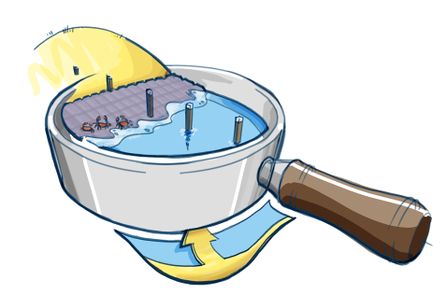Building with Nature: verschil tussen versies
Geen bewerkingssamenvatting |
Geen bewerkingssamenvatting |
||
| Regel 1: | Regel 1: | ||
[[Bestand:Building with Nature.jpg|thumb|447x447px]] | [[Bestand:Building with Nature.jpg|thumb|447x447px]] | ||
As a result of changes in societal demand and technical developments, water management and engineering are moving from hard traditional structures like dikes and dams, to designs in which natural structures and processes are incorporated. One of the underlying factors in this development is the increasing awareness of the impacts of climate change and its effect on water levels and extreme events. Furthermore, water managers are expected to create more safety, opportunities for recreation, and other benefits, with increasingly smaller budgets. This requires infrastructure that combines multiple functions. In our research group we work on application of the Building with Nature concept. ‘Building with Nature’ focusses on solutions that use abiotic forces of nature (e.g. wind and currents that transport sand) and ecosystem services delivered by organisms (e.g. reefs and vegetation that catch and stabilize sand). The research group also focusses on Building for Nature: creating additional nature values in and on monofunctional structures such as dikes. | As a result of changes in societal demand and technical developments, water management and engineering are moving from hard traditional structures like dikes and dams, to designs in which natural structures and processes are incorporated. One of the underlying factors in this development is the increasing awareness of the impacts of climate change and its effect on water levels and extreme events. Furthermore, water managers are expected to create more safety, opportunities for recreation, and other benefits, with increasingly smaller budgets. This requires infrastructure that combines multiple functions. | ||
<br /> | |||
<br /> | |||
In our research group we work on application of the Building with Nature concept. ‘Building with Nature’ focusses on solutions that use abiotic forces of nature (e.g. wind and currents that transport sand) and ecosystem services delivered by organisms (e.g. reefs and vegetation that catch and stabilize sand). The research group also focusses on Building for Nature: creating additional nature values in and on monofunctional structures such as dikes. | |||
<br /> | |||
<br /> | |||
Current research themes include: | Current research themes include: | ||
#Optimizing the design of Building with Living Nature structures such as oyster reefs or salt marshes, used for coastal protection and nature development | #Optimizing the design of Building with Living Nature structures such as oyster reefs or salt marshes, used for coastal protection and nature development | ||
| Regel 7: | Regel 12: | ||
#Tidal restoration projects | #Tidal restoration projects | ||
#Transfer of knowledge by means of an expertise management | #Transfer of knowledge by means of an expertise management | ||
<br /> | |||
=== Are you interested to particpate? === | === Are you interested to particpate? === | ||
Students have the possibility to participate in applied research. Students that are interested in an internship or final thesis can apply by sending a motivation lette to Tim van Oijen ([mailto:tim.van.oijen@hz.nl <u>tim.van.oijen@hz.nl</u>]). | Students have the possibility to participate in applied research. Students that are interested in an internship or final thesis can apply by sending a motivation lette to Tim van Oijen ([mailto:tim.van.oijen@hz.nl <u>tim.van.oijen@hz.nl</u>]). | ||
<br /> | |||
<br /> | |||
{{Projecten | {{Projecten | ||
|Supercontext=Sustainable Dynamic Delta, | |Supercontext=Sustainable Dynamic Delta, | ||
Versie van 8 sep 2018 09:06
As a result of changes in societal demand and technical developments, water management and engineering are moving from hard traditional structures like dikes and dams, to designs in which natural structures and processes are incorporated. One of the underlying factors in this development is the increasing awareness of the impacts of climate change and its effect on water levels and extreme events. Furthermore, water managers are expected to create more safety, opportunities for recreation, and other benefits, with increasingly smaller budgets. This requires infrastructure that combines multiple functions.
In our research group we work on application of the Building with Nature concept. ‘Building with Nature’ focusses on solutions that use abiotic forces of nature (e.g. wind and currents that transport sand) and ecosystem services delivered by organisms (e.g. reefs and vegetation that catch and stabilize sand). The research group also focusses on Building for Nature: creating additional nature values in and on monofunctional structures such as dikes.
Current research themes include:
- Optimizing the design of Building with Living Nature structures such as oyster reefs or salt marshes, used for coastal protection and nature development
- Sediment dynamics on sand nourishment locations
- Rich revetments: Building for Nature on dikes
- Tidal restoration projects
- Transfer of knowledge by means of an expertise management
Are you interested to particpate?
Students have the possibility to participate in applied research. Students that are interested in an internship or final thesis can apply by sending a motivation lette to Tim van Oijen (tim.van.oijen@hz.nl).

